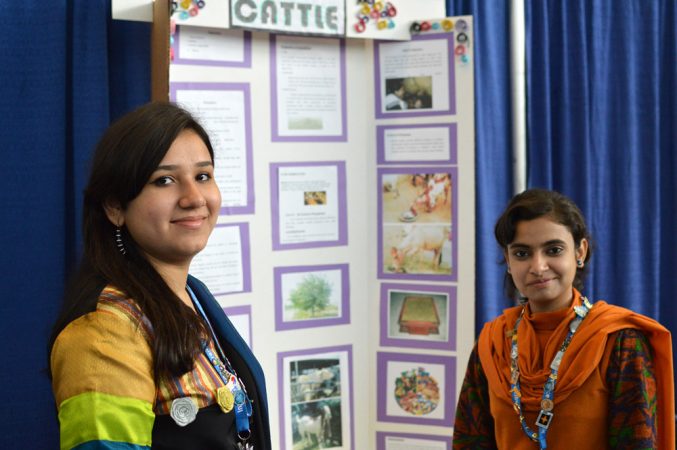Granola bars for cows
Nutrient-rich “energy squares” boost milk production, help prevent disease
By Sid Perkins

A food supplement for cattle that’s made from ingredients that are typically discarded could inexpensively boost milk production. The chow may also help prevent disease in cattle, goats and other farm animals.
The recipe sounds a lot like what you’d mix to make a really big granola bar — one that weighs 8 kilograms, in fact. But almost 80 percent of the ingredients in these “energy squares” are either by-products of other food-making processes or aren’t considered safe for people to eat, say Shiza Gulab, Mahnoor Hassan and Bushra Shahed — all 17-year-old 11th–graders from the Institute of Computer and Management Sciences in Peshawar, Pakistan.
A little more than 25 percent of each energy square is molasses, a by-product of making sugar. About 22 percent is mulberries that have fallen to the ground and therefore can’t be sold at market. Almost one-third of the ingredients are wheat bran, bran made from maize (also known as corn) and rice polish — a dust-like material that clings to rice grains and is rich in carbohydrates.
Most of the remaining ingredients are vitamins, minerals and urea (a nitrogen-rich substance that helps animals digest low-quality grass, grain or hay). Added clay absorbs moisture from the mixture and makes it firm. Finally, a small bit of medicine is thrown in to kill roundworms in the digestive system.
The high-school inventors shared this recipe May 15 at the Intel International Science and Engineering Fair in Pittsburgh, Pa.This event is sponsored by Intel Foundation and run by the Society for Science & the Public (which publishes Science News for Kids).
Making the energy squares is simple: Just combine the ingredients in the proper proportions, pack the mixture into a wooden mold and then set it in the shade for 48 hours to dry and harden. The energy squares don’t spoil quickly, so they can be stored in any dry location for weeks after they’re made. And because most of the ingredients are cast-offs, each energy square costs less than $1 (U.S.).
That small cost provides great benefits, the team says. Not only do the energy squares reduce or eliminate the effects of calcium deficiency due to poor or inadequate forage, but they also boost a cow’s milk production by 30 to 50 percent, the team’s tests suggest.
The energy squares can be fed to cattle, goats, sheep, ox and buffalo, the young inventors say. Unlike granola bars designed for human consumption, these developed for livestock aren’t for chewing; the animals merely lick them. A cow eats about 300 grams of the square a day, so one 8-kilogram energy square should last almost four weeks for a single cow — or provide one day’s supplemental nourishment for a herd of 26 cows.
This is one in a series of articles covering the Intel ISEF 2012 competition. Check back soon for more stories.